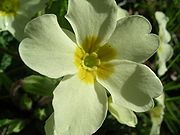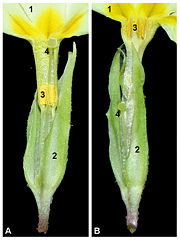- Heterostyly
-
Heterostyly is a unique form of polymorphism and herkogamy in flowers. In a heterostylous species, two or three different morphological types of flowers, termed morphs, exist in the population. On each individual plant, all flowers share the same morph. The flower morphs differ in the lengths of the pistil and stamens, and these traits are not continuous. The morph phenotype is genetically linked to genes responsible for a unique system of self-incompatibility, termed heteromorphic self-incompatibility, that is, the pollen from a flower on one morph cannot fertilize another flower of the same morph.
Heterostylous plants having two flower morphs are termed distylous. In one morph (termed pin or longuistylous flower) the stamens are short and the pistils are long; in the second morph (termed thrum or brevistylous flower) the stamens are long and the pistils are short; the length of the pistil in one morph equals the length of the stamens in the second morph, and vice versa.[1][2] Examples of distylous plants are the primrose and many other Primula species,[1][2] flax and other Linum species, purple loosestrife and other Lythrum species,[3] and many species of Cryptantha.[4]
Heterostylous plants having three flower morphs are termed tristylous. Each morph has two types of stamens. In one morph, the pistil is short, and the stamens are long and intermediate; in the second morph, the pistil is intermediate, and the stamens are short and long; in the third morph, the pistil is long, and the stamens are short and intermediate. Oxalis pes-caprae and some species of Lythrum are trimorphic.[3]
The different lengths of stamens and pistils in heterostylous flowers are adapted for pollination by different pollinators, or different body parts of the same pollinator. Thus, pollen originating in a long stamen will reach primarily long rather than short pistils, and vice versa.[1][2] When pollen is transferred between two flowers of the same morph, no fertilization will take place, because of the self-incompatibility mechanism.
References
- ^ a b c Darwin, Charles 1862. On the two forms, or dimorphic condition, in the species of Primula, and on their remarkable sexual relations. Journal of the Proceedings of the Linnaean Society (Botany) 6, 77–96.
- ^ a b c Darwin, Charles 1877. The different forms of flowers on plants of the same species. Murray, London.
- ^ a b Barrett, PH (ed) 1977. The collected papers of Charles Darwin. Chicago University Press.
- ^ Cronquist, Arthur, Arthur H. Holmgren, Noel H. Holmgren, James L. Reveal, Patricia K. Holmgren (1984). Intermountain Flora; Vascular Plants of the Intermountain West, U.S.A., vol. 4. Subclass Asteridae (except Asteraceae). The New York Botanical Garden. p. 224. ISBN 0-893-27248-5.
Categories:
Wikimedia Foundation. 2010.



